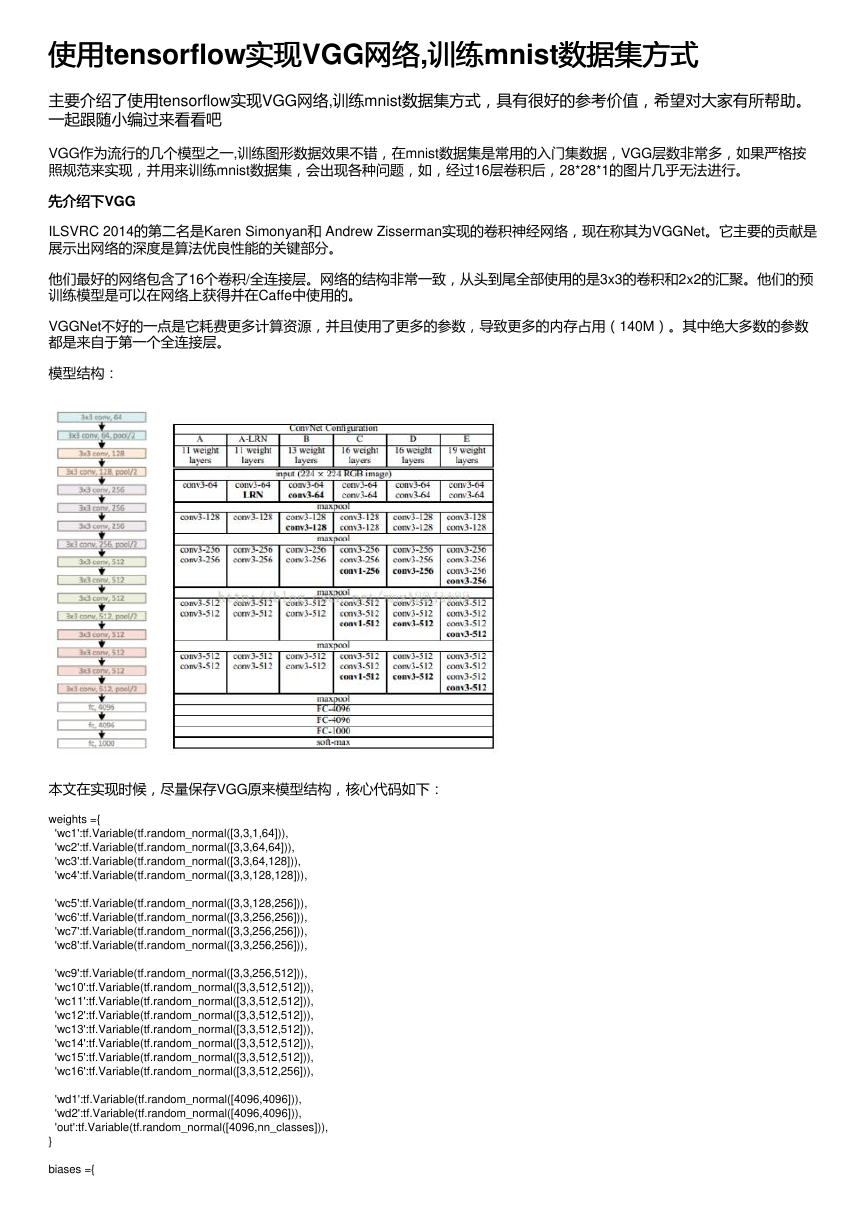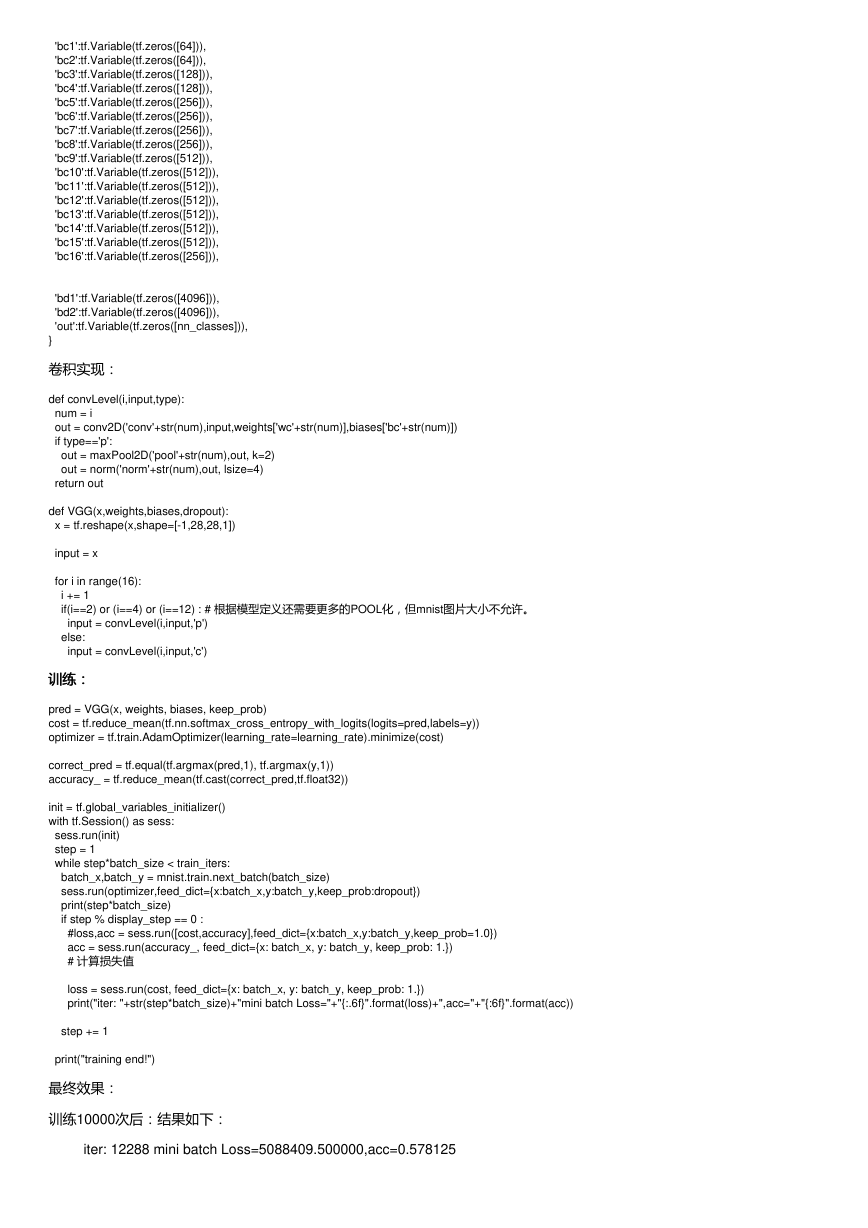使用使用tensorflow实现实现VGG网络网络,训练训练mnist数据集方式
数据集方式
主要介绍了使用tensorflow实现VGG网络,训练mnist数据集方式,具有很好的参考价值,希望对大家有所帮助。
一起跟随小编过来看看吧
VGG作为流行的几个模型之一,训练图形数据效果不错,在mnist数据集是常用的入门集数据,VGG层数非常多,如果严格按
照规范来实现,并用来训练mnist数据集,会出现各种问题,如,经过16层卷积后,28*28*1的图片几乎无法进行。
先介绍下VGG
先介绍下
ILSVRC 2014的第二名是Karen Simonyan和 Andrew Zisserman实现的卷积神经网络,现在称其为VGGNet。它主要的贡献是
展示出网络的深度是算法优良性能的关键部分。
他们最好的网络包含了16个卷积/全连接层。网络的结构非常一致,从头到尾全部使用的是3x3的卷积和2x2的汇聚。他们的预
训练模型是可以在网络上获得并在Caffe中使用的。
VGGNet不好的一点是它耗费更多计算资源,并且使用了更多的参数,导致更多的内存占用(140M)。其中绝大多数的参数
都是来自于第一个全连接层。
模型结构:
本文在实现时候,尽量保存VGG原来模型结构,核心代码如下:
weights ={
'wc1':tf.Variable(tf.random_normal([3,3,1,64])),
'wc2':tf.Variable(tf.random_normal([3,3,64,64])),
'wc3':tf.Variable(tf.random_normal([3,3,64,128])),
'wc4':tf.Variable(tf.random_normal([3,3,128,128])),
'wc5':tf.Variable(tf.random_normal([3,3,128,256])),
'wc6':tf.Variable(tf.random_normal([3,3,256,256])),
'wc7':tf.Variable(tf.random_normal([3,3,256,256])),
'wc8':tf.Variable(tf.random_normal([3,3,256,256])),
'wc9':tf.Variable(tf.random_normal([3,3,256,512])),
'wc10':tf.Variable(tf.random_normal([3,3,512,512])),
'wc11':tf.Variable(tf.random_normal([3,3,512,512])),
'wc12':tf.Variable(tf.random_normal([3,3,512,512])),
'wc13':tf.Variable(tf.random_normal([3,3,512,512])),
'wc14':tf.Variable(tf.random_normal([3,3,512,512])),
'wc15':tf.Variable(tf.random_normal([3,3,512,512])),
'wc16':tf.Variable(tf.random_normal([3,3,512,256])),
'wd1':tf.Variable(tf.random_normal([4096,4096])),
'wd2':tf.Variable(tf.random_normal([4096,4096])),
'out':tf.Variable(tf.random_normal([4096,nn_classes])),
}
biases ={
�
'bc1':tf.Variable(tf.zeros([64])),
'bc2':tf.Variable(tf.zeros([64])),
'bc3':tf.Variable(tf.zeros([128])),
'bc4':tf.Variable(tf.zeros([128])),
'bc5':tf.Variable(tf.zeros([256])),
'bc6':tf.Variable(tf.zeros([256])),
'bc7':tf.Variable(tf.zeros([256])),
'bc8':tf.Variable(tf.zeros([256])),
'bc9':tf.Variable(tf.zeros([512])),
'bc10':tf.Variable(tf.zeros([512])),
'bc11':tf.Variable(tf.zeros([512])),
'bc12':tf.Variable(tf.zeros([512])),
'bc13':tf.Variable(tf.zeros([512])),
'bc14':tf.Variable(tf.zeros([512])),
'bc15':tf.Variable(tf.zeros([512])),
'bc16':tf.Variable(tf.zeros([256])),
'bd1':tf.Variable(tf.zeros([4096])),
'bd2':tf.Variable(tf.zeros([4096])),
'out':tf.Variable(tf.zeros([nn_classes])),
}
卷积实现:
def convLevel(i,input,type):
num = i
out = conv2D('conv'+str(num),input,weights['wc'+str(num)],biases['bc'+str(num)])
if type=='p':
out = maxPool2D('pool'+str(num),out, k=2)
out = norm('norm'+str(num),out, lsize=4)
return out
def VGG(x,weights,biases,dropout):
x = tf.reshape(x,shape=[-1,28,28,1])
input = x
for i in range(16):
i += 1
if(i==2) or (i==4) or (i==12) : # 根据模型定义还需要更多的POOL化,但mnist图片大小不允许。
input = convLevel(i,input,'p')
else:
input = convLevel(i,input,'c')
训练:训练:
pred = VGG(x, weights, biases, keep_prob)
cost = tf.reduce_mean(tf.nn.softmax_cross_entropy_with_logits(logits=pred,labels=y))
optimizer = tf.train.AdamOptimizer(learning_rate=learning_rate).minimize(cost)
correct_pred = tf.equal(tf.argmax(pred,1), tf.argmax(y,1))
accuracy_ = tf.reduce_mean(tf.cast(correct_pred,tf.float32))
init = tf.global_variables_initializer()
with tf.Session() as sess:
sess.run(init)
step = 1
while step*batch_size < train_iters:
batch_x,batch_y = mnist.train.next_batch(batch_size)
sess.run(optimizer,feed_dict={x:batch_x,y:batch_y,keep_prob:dropout})
print(step*batch_size)
if step % display_step == 0 :
#loss,acc = sess.run([cost,accuracy],feed_dict={x:batch_x,y:batch_y,keep_prob=1.0})
acc = sess.run(accuracy_, feed_dict={x: batch_x, y: batch_y, keep_prob: 1.})
# 计算损失值
loss = sess.run(cost, feed_dict={x: batch_x, y: batch_y, keep_prob: 1.})
print("iter: "+str(step*batch_size)+"mini batch Loss="+"{:.6f}".format(loss)+",acc="+"{:6f}".format(acc))
step += 1
print("training end!")
最终效果:
训练10000次后:结果如下:
iter: 12288 mini batch Loss=5088409.500000,acc=0.578125
�
iter: 12800 mini batch Loss=4514274.000000,acc=0.601562
iter: 13312 mini batch Loss=4483454.500000,acc=0.648438
这种深度的模型可以考虑循环10万次以上。目前效果还不错,本人没有GPU,心痛笔记本的CPU,100%的CPU利用率,听
到风扇响就不忍心再训练,本文也借鉴了alex网络实现,当然我也实现了这个网络模型。在MNIST数据上,ALEX由于层数较
少,收敛更快,当然MNIST,用CNN足够了。
以上这篇使用tensorflow实现VGG网络,训练mnist数据集方式就是小编分享给大家的全部内容了,希望能给大家一个参考,也
希望大家多多支持我们。
�






 2023年江西萍乡中考道德与法治真题及答案.doc
2023年江西萍乡中考道德与法治真题及答案.doc 2012年重庆南川中考生物真题及答案.doc
2012年重庆南川中考生物真题及答案.doc 2013年江西师范大学地理学综合及文艺理论基础考研真题.doc
2013年江西师范大学地理学综合及文艺理论基础考研真题.doc 2020年四川甘孜小升初语文真题及答案I卷.doc
2020年四川甘孜小升初语文真题及答案I卷.doc 2020年注册岩土工程师专业基础考试真题及答案.doc
2020年注册岩土工程师专业基础考试真题及答案.doc 2023-2024学年福建省厦门市九年级上学期数学月考试题及答案.doc
2023-2024学年福建省厦门市九年级上学期数学月考试题及答案.doc 2021-2022学年辽宁省沈阳市大东区九年级上学期语文期末试题及答案.doc
2021-2022学年辽宁省沈阳市大东区九年级上学期语文期末试题及答案.doc 2022-2023学年北京东城区初三第一学期物理期末试卷及答案.doc
2022-2023学年北京东城区初三第一学期物理期末试卷及答案.doc 2018上半年江西教师资格初中地理学科知识与教学能力真题及答案.doc
2018上半年江西教师资格初中地理学科知识与教学能力真题及答案.doc 2012年河北国家公务员申论考试真题及答案-省级.doc
2012年河北国家公务员申论考试真题及答案-省级.doc 2020-2021学年江苏省扬州市江都区邵樊片九年级上学期数学第一次质量检测试题及答案.doc
2020-2021学年江苏省扬州市江都区邵樊片九年级上学期数学第一次质量检测试题及答案.doc 2022下半年黑龙江教师资格证中学综合素质真题及答案.doc
2022下半年黑龙江教师资格证中学综合素质真题及答案.doc